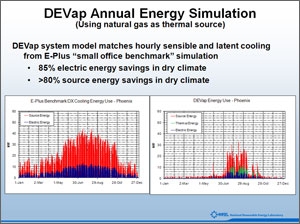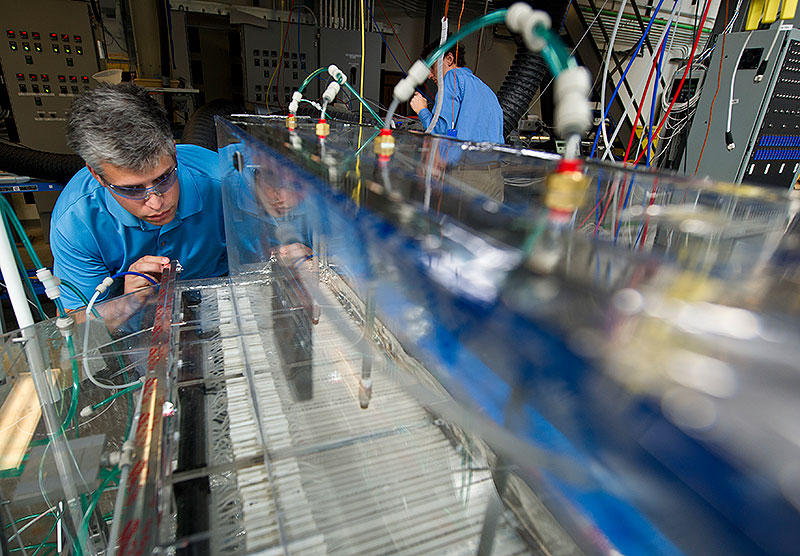Core Technology and Future of Devap Cooling
Who Can Manufacture deVAP?
 NREL senior engineer Eric Kozubal examines a prototype air flow channel of the DEVap air conditioner, which he co-invented.
NREL senior engineer Eric Kozubal examines a prototype air flow channel of the DEVap air conditioner, which he co-invented.
DEVap, which stands for desiccant-enhanced evaporative air conditioner, is a novel concept that uses membrane technology to combine the efficiency of evaporative cooling and the drying potential of liquid desiccant salt solutions.
The graph superimposed on the photo shows shows how hot humid air, in red, changes to cool dry air, in blue, as the air passes through the DEVap core.
New AC Technology - Devap

New AC Technology Could Yield Significant
Energy Savings
Article by Bill Scanlon, National Renewable Energy Laboratory, reprinted with permission.
Ah, the cool, refreshing feel of air conditioning on a sweltering summer day.
Ugh, the discomfort when those energy bills in July, August and September come due — $200, $400, $600 or more.
Feel miserable, or dig deep into your wallet — not much of a choice for the 250 million Americans who live in climates where heat, humidity or both are a Catch-22 for three to 12 months a year.
A soothing solution may be on its way, thanks to a melding of technologies in filters, coolers and drying agents.
Devap Cooling & Hot and Humid Climates
Devap Cooling & Hot and Humid Climates
Evaporative coolers are a lower-cost alternative to A/C in dry climates that don’t get too hot or humid — say, Denver, but not Phoenix or Miami. Water flows over a mesh, and a fan blows air through the wet mesh to create humid, cool air.
In humid climes, adding water to the air creates a hot and sticky building environment. Furthermore, the air cannot absorb enough water to become cold.
 This illustration shows how the DEVap cooling core uses water and liquid desiccant to draw in outside air, exhaust some of that air and return cool, dry air to the area being cooled. DEVap’s integrated evaporative component and its desiccant drying process offer improved dehumidification and, thus lower costs and much lower energy usage In Phoenix or Tucson, the evaporative cooler can bring down the temperature, but not enough to make it pleasant inside on a 100-degree day or during the four to eight week moist period known as monsoon season. The cooling bumps up against the wet bulb temperature, the lowest temperature to which air can be cooled by evaporating without changing the pressure. The wet bulb temperature could be 75 or 80 degrees on a mid-summer Tucson day. Typically, evaporative coolers only can bring the temperatures about 85 percent of the way to the wet bulb level. So, for most of the country, refrigeration-based air conditioning is the preferred way of keeping cool. . |
Cooling Requires Temperature Drop and Less Moisture
Cooling comes in two forms — sensible cooling, which is a temperature drop, and latent cooling, which comes from pulling the moisture out of the air.
One intriguing product already on the market in arid, temperate climates is the Coolerado cooler. It differs from a typical evaporative cooler by never increasing the moisture content of the supply air. It provides cool air through indirect evaporative cooling. Indirect evaporative systems use a purge air stream that removes heat from the product or supply air stream that is then directed into a building.
That way, the Coolerado can cool the air all the way to the wet-bulb temperature.
“It’s a big improvement on evaporative cooling because it doesn’t add moisture and still gives you cold air,” Kozubal said. However, in a humid climate, it still does not provide cold air or humidity control.

